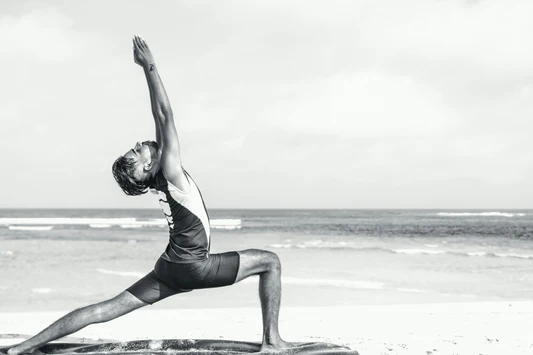Static Stretching. You either love it or hate it.
I apologize in advance for using the clickbait title, but I firmly believe this article may change your mind on a common practice you have been doing for years before running, biking, and other endurance activities.
For decades you’ve been told this practice prevents injuries, decreases muscle soreness, and makes you go faster. The practice I’m referring to is STRETCHING.
Static Stretching Definition
More specifically, the grab and hold method of stretching known as static stretching. I’m sure you are all familiar with the drill. You warm up for 5-10 minutes, find a nice grassy spot under a tree, and pull and yank on your muscles to your heart's content.
Is Static Stretching Good?
Now comes the part that may be a little hard to swallow for some. Brace yourself…performing static stretching before endurance exercise is a complete waste of time.
You’ll get no argument from me that it will make you more flexible but there is not one piece of scientific evidence showing that static stretching helps you stay injury free, lessens muscle soreness, or helps you perform better.
Actually, it’s quite the opposite. Multiple studies have shown that static stretching can DECREASE endurance performance when performed before a workout or race. Why is this?
Part of the reason endurance performance decreases after static stretching is that it relaxes the muscles and associated tendons
A word about stretch response
This relaxation reduces the stretch response. Because a muscle and its tendons store energy when being rapidly stretched (often called a countermovement), reducing this stretch response weakens the endurance athlete.
During a run, the relaxation of the muscle and tendons may similarly affect the phase in which you push off of the ground. As your foot makes contact with the ground, it stores energy, which it then uses to drive you into the air. This is why at fast speeds, running is more efficient than walking.
The primary difference in energy output when running is in ground contact time.
In all sports that involve running, it’s well known that contact time with the ground limits performance. If the ability to push off the ground is reduced by stretching, then it stands to reason that static stretching might also hinder endurance performance, specifically by decreasing running economy.
Essentially, running after static stretching will require more energy
Studies Examining Static Stretching And Athletic Performance
At this point, you may think I am full of it and feeding you a bunch of poppycock so let’s see what the science has to say.
In the first study, the researchers (one who is the co-founder of EndurElite) noted that running economy is likely affected by static stretching, but only at the start of endurance exercise, after which the body acclimates and economy improves.
They looked at performance over a short run of one mile. The mile test was at a five percent uphill grade, which increased the strength component required to maintain a low contact time.
The researchers measured more than just the time it took to complete the mile. If there was a difference in performance, they wanted to know why. So they also looked at ground contact time and also muscle activation via electromyography (EMG).
When the runners stretched, they were indeed slower at running the mile by a full thirteen seconds, which is quite a long time in a one-mile run.
The researchers found that muscle activity and ground contact both increased after stretching, indicating it took more effort to complete the run which resulted in the slower times.
The researchers did find that flexibility was greater after stretching, which came as no surprise.
This study demonstrated that static stretching does, in fact, reduce endurance performance, at least at the beginning of a run.
- The effect is probably caused by a reduction in running economy, and while it seems to fade over the course of a long run, it’s significant at the beginning of a run.
- Enough so that static stretching should be avoided even in long-distance runners.
In a second study, researchers at the University of Milan argued that the performance-damping effects of stretching may be more obvious in endurance cycling than in running.
The reason is that type II muscle fibers (a.k.a. fast twitch) are affected more than type I muscle fibers (slow twitch) by stretching. When you’re running at below-threshold paces, your leg muscles are only applying about 20% of their maximal force, so they can rely mainly on type I fibers.
Cycling, on the other hand, requires a greater proportion of maximal force: about 60% of max force at 85% VO2max, according to the paper.
As a result, cyclists recruit a higher proportion of type II fibers, and are thus more vulnerable to stretching-induced weakness
Static Stretching Reduces Muscular Efficiency
That’s all fine in theory — but what do the experiments say? The researchers did a series of tests of VO2max, mechanical efficiency, time to exhaustion (with the power set at 85% of power at VO2max, so that exhaustion took about 30 minutes), and so on.
Here are the efficiency results, with open circles corresponding to no stretching and closed circles corresponding to 30-minute pre-exercise stretching routine:

On average, efficiency was about 4% lower after stretching. Time to exhaustion was decreased by 26% after stretching (22:57 vs. 31:12).
Sorry to piss in your cheerios this Wednesday morning but I’ll say it again, static stretching before endurance exercise is a complete waste of time and can decrease performance.
The studies above are only two examples of the massive amount of research that exists on the topic.
By now you're probably wondering what you should do instead of stretching to make sure you are adequately warmed up before a workout or race. The solution is quit simple....dynamic stretching!
Dynamic vs. static stretching
- Start at an easy pace for the first 5-10 minutes of your workout and bump up the speed and intensity over the course of the workout.
- In race type situations warm-up at an easy pace for 10-20 minutes before race time followed by 5-6 harder efforts (sprint, strides, etc…) lasting anywhere from 10 to 120 seconds. This will elevate heart rate, efficiently get blood to working muscles, and have you ready to go balls to the wall when the gun fires without blowing up in the first mile.
- If not stretching is not an option before a workout or race and you absolutely feel like you need to, perform dynamic stretching after your warm-up. Dynamic stretching involves no grabbing and holding of limbs but instead mimics the movements you will be performing during a workout or race. Good examples of dynamic stretching are high knees, butt kicks, skipping, and sprinting.
- If you love static stretching so much that you can't live without it, perform after your workout and cooldown.
When To Static Stretch
I’ll admit that static stretching does have a place in sports like gymnastics and underwater basket weaving where being more flexible is advantageous.
It may also help in individual’s who lack proper mobility. But that’s about it. So save 15 minutes of your day by not stretching before your next workout or race and use that time to grab a beer afterward. It’s probably better for you.
References:
Lowery, R. P., Joy, J. M., Brown, L. E., de Souza, E. O., Wistocki, D. R., Davis, G. S., ... & Wilson, J. M. (2014). Effects of static stretching on 1-mile uphill run performance. The Journal of Strength & Conditioning Research, 28(1), 161-167.
Esposito, F., Ce, E., & Limonta, E. (2012). Cycling efficiency and time to exhaustion are reduced after acute passive stretching administration. Scandinavian journal of medicine & science in sports, 22(6), 737-745.


